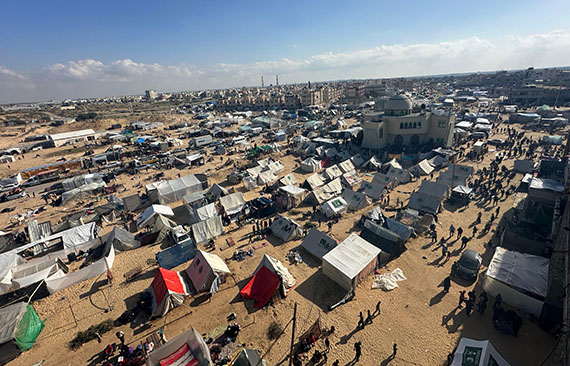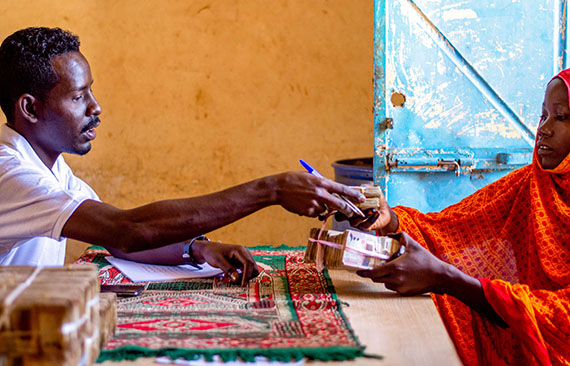Dear friend,
Right now, families in Gaza and Sudan are living through devastating emergencies caused by ongoing violent conflict. From famine-like conditions to mass displacement, the needs are extraordinary — and Mercy Corps teams and partners are doing everything possible to deliver life-saving humanitarian aid to those who are affected.
This month’s emergency update includes updates from both Gaza and Sudan — including the extent of the challenges facing local communities and Mercy Corps’ ongoing emergency response. Please read on for further updates — and if you’re ready to contribute to our work supporting families in crisis worldwide, consider making your first gift to Mercy Corps to help power our life-saving impact.
Situation in Gaza

Thousands of displaced people are staying in makeshift tents after being displaced from various parts of Gaza but the ongoing conflict. © Shadow Pro for Mercy Corps
 |
The situation in Gaza continues to worsen as aid is still severely restricted from entering impacted areas. In April, Samantha Power, the director of the U.S. Agency for International Development (USAID), told U.S. leaders that famine had begun in Gaza, and since then the situation has continued to deteriorate.
 |
 |
 |
Half of the population of Gaza — around 1.1 million Palestinians — are facing catastrophic levels of hunger and starvation. The entire population — around 2.2 million people — are facing high levels of acute food insecurity. |
| |
 |
 |
More than 33,000 Palestinians, at least 14,500 of them children, have been killed over the last six months. More than 75,000 people have been injured, many with life-changing injuries that will leave them with permanent disabilities. |
| |
 |
 |
Over 70% of Gaza’s population, around 1.7 million people, has been forcibly displaced. More than 70% of Gaza’s homes, much of its schools, and its water and sanitation infrastructure have been destroyed or damaged. |
| |
 |
 |
Not a single medical facility in Gaza is fully operational, and those partially functioning are overwhelmed with trauma cases and shortages of medical supplies and doctors. More than 489 health workers have been killed. |
| |
 |
 |
At least 243 aid workers in Gaza have been killed, the highest of any conflict in this century. |
 |
How we’re responding
Mercy Corps teams are on the ground, bringing urgent and desperately needed aid to the people of northern Gaza. To date, we have distributed over 40,100 food baskets and over 19,900 hygiene kits. Distribution efforts are ongoing, and we expect to deliver an additional 27,300 food, hygiene, and shelter kits in the coming weeks.
So far, this war has taken thousands of lives and severely impacted millions of families — putting them on the brink of famine. Only a sustained ceasefire and an end to the siege coupled with the massive scale-up of humanitarian aid can prevent continued civilian death and destruction in Gaza.
You can read more about the ongoing crisis in Gaza and how Mercy Corps is responding on our website.
Situation in Sudan

Mercy Corps provides direct cash assistance to community members in several states across the southern area of Sudan. People are then able to buy food and water for themselves and their families.
This month marked the one-year milestone since the civil war broke out in Sudan. Since then, Sudanese people have suffered imaginable atrocities. Since April 2023, more than 8 million people have been displaced from their homes, and more than 14,000 people have been killed. The reality is that this number could be much higher, as it is nearly impossible for outside observers to enter the country.
Due to the humanitarian crises happening in Gaza and Ukraine, the conflict has not received the international attention or humanitarian response it demands. With 24.8 million people in need of humanitarian assistance in 2024, we cannot allow the crisis in Sudan to be forgotten.
How we’re responding
Recently, Mercy Corps CEO Tjada D’Oyen McKenna, delivered a speech in France at the International Humanitarian Conference for Sudan and its Neighboring Countries to call for more funding for humanitarian aid to Sudan. She reminded the audience that "the threat of famine is real, with hundreds of thousands at risk of perishing, including some 230,000 children, pregnant women, and new mothers."
At that conference, 58 countries pledged $2.1 billion worth of humanitarian aid to address the famine and the many urgent needs in the country. But as our CEO explains, "The $2.1 billion that has been pledged represents just 20 cents per day for each person in dire need of assistance."
Mercy Corps’ work in Sudan started in 2004, providing support to thousands of displaced and refugee families. Beyond rapid humanitarian response to emergencies, Mercy Corps has been able to implement development programs to promote agricultural and economic efforts and peacebuilding programs to protect women from violent conflicts.
The violence from the civil war has severely limited humanitarian aid organizations’ ability to deliver aid; however, our teams are monitoring the situation and are committed to delivering the lifesaving support that is needed in Sudan.
You can read more about the ongoing crisis in Sudan and how Mercy Corps is responding on our website.
Responding effectively to urgent needs due to war, natural disasters, and other emergencies requires people from every corner to pitch in. Mercy Corps is working with multiple partners to help families in Gaza, Sudan, and 40+ countries around the world, but the needs continue to grow.
Will you make a one-time gift right now to help support our work to deliver lifesaving aid in Gaza, Sudan, and 40+ countries worldwide?
Sincerely,
The Mercy Corps team
|


